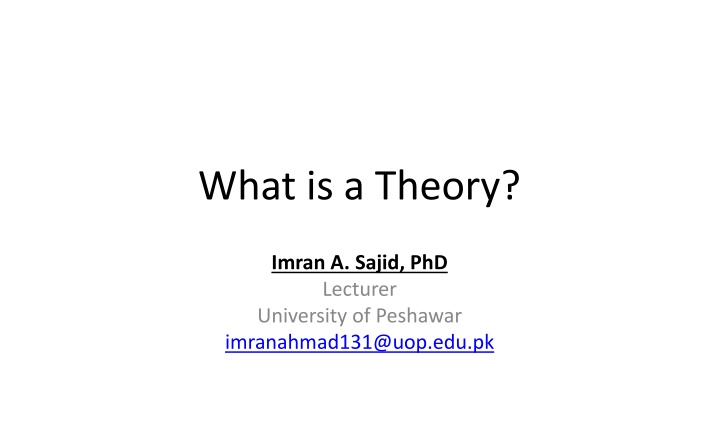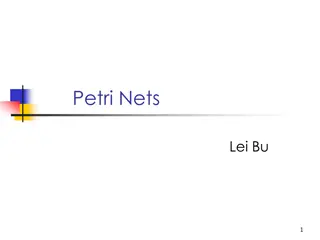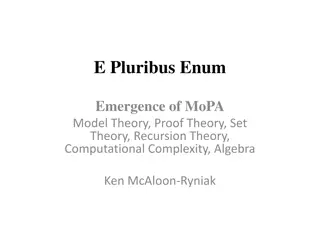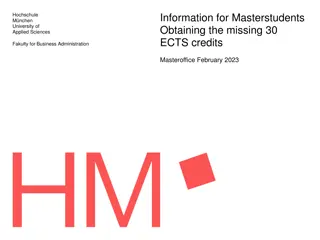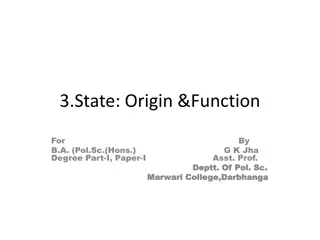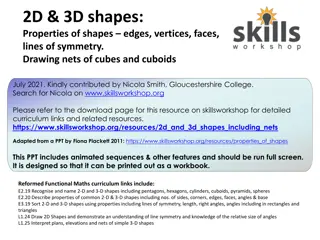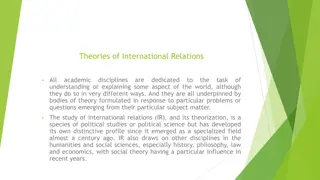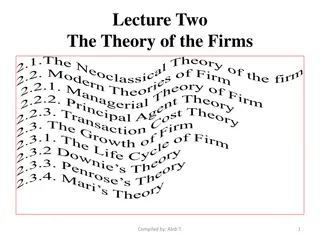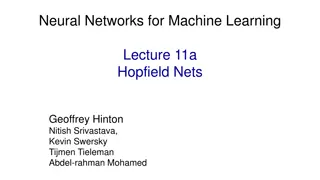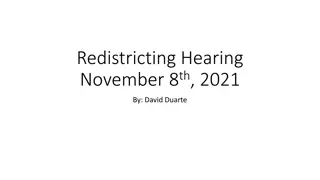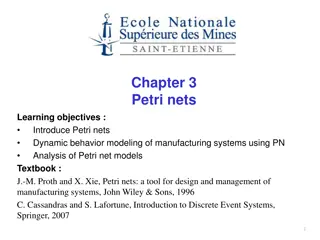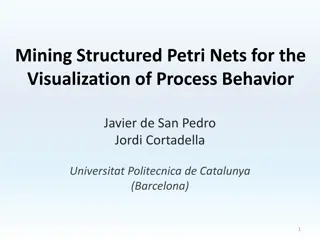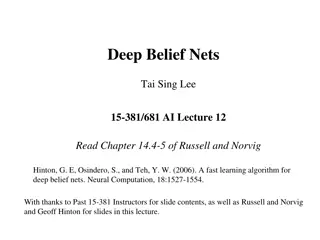Theory: Nets to Rationalize, Explain, Master
The concept of theory is explored through the works of Imran A. Sajid, Ph.D., and definitions by various scholars. Essential elements of a theory, including concepts, facts, hypotheses, and principles, are dissected along with the role of concepts in theory-building, particularly in social work practice. The Theory of Diffused Responsibility and insights into the essence of theories in understanding the world are also discussed.
Download Presentation

Please find below an Image/Link to download the presentation.
The content on the website is provided AS IS for your information and personal use only. It may not be sold, licensed, or shared on other websites without obtaining consent from the author.If you encounter any issues during the download, it is possible that the publisher has removed the file from their server.
You are allowed to download the files provided on this website for personal or commercial use, subject to the condition that they are used lawfully. All files are the property of their respective owners.
The content on the website is provided AS IS for your information and personal use only. It may not be sold, licensed, or shared on other websites without obtaining consent from the author.
E N D
Presentation Transcript
What is a Theory? Imran A. Sajid, PhD Lecturer University of Peshawar imranahmad131@uop.edu.pk
Abner Louima a 30 year old male Haitian immigrant New York City Police station Kitty Gen New York 1960 48 neighbours heard scream Puzzle How so many people could stand by without coming to the aid of the victims? 3
Bibb Lantane and John Darley Theory of diffused responsibility The greater the number of bystanders or witnesses to an event that calls for helping behaviour, the more the responsibility for helping is perceived to be shared by all the bystanders. Because of this sense of shared responsibility, then the more people present in an emergency situation, the less personally responsible each person feels---and the less likely it is that any single person will come forward to help. 4
Definitions 1. Theories are nets cast to catch what we call the world : to rationalize, to explain, and to master it. We endeavour to make the mesh finer and finer (Popper, 1959). 2. Theory is a story about how and why events in the universe occur (Turner, 1991). 3. Theory is a model of reality appropriate to a particular discipline. Such a model helps us to understand what is, what is possible, and how to achieve the possible (Turner, 1995). 5
Essential Elements of a Theory 1. Concepts 2. Facts 3. Hypothesis 4. Principles 6
CONCEPTS 7
1. Concepts Concepts are building blocks of theory. Concepts are abstractions representing logical descriptions of reality that a discipline develops to describe the phenomena with which it is dealing. Concepts are thus the labels by which we communicate with others within a discipline. They are greed-upon terms that describe our practice world. A concept is not a phenomenon (something experienced; a fact) but a formulation about a phenomenon that is derived from abstractions based on our experiences. 8
Some concepts in social work practice are Rapport Relationship Personality strengths Empowerment Juvenile Delinquency Coping Crisis Self-identity Defence mechanism
Meanings of a Concept Scientific Non-Scientific 10
Example Concept Non-Scientific Meaning Scientific Meaning Mass Big pile of something Quality of matter that can be measured by certain operations Function Any kind of activity Purpose, object, role Juvenile Youthful/not yet mature Youthful/not yet mature State Country a country's government and those government- controlled institutions that are responsible for its internal administration and its relationships with other countries War Fight between countries a period of hostile relations between countries, states, or factions that leads to fighting between armed forces, especially in land, air, or sea battles 11
To simplify, concepts are of two types Types of Concept 1. Variable Concepts A v.c is a concept that varies. Expresses value, intensity, quantity, amount Example: income, temperature, density of population, years of schooling, degree of violence 2. Non-variable concepts Express categories: example, bureaucracy, family, college degree, cold, terrorism 12
Scope of a Concept Concepts vary as to scope. 1. Narrow 2. Broad Broad concepts are more abstract than narrow concepts 13
1. Narrow: Apply only to specific social settings Are restricted in time or place Example: football hooliganism: Violence by British and, to a degree, other European soccer fans that have accelerated since the late 1960s. 14
2. Broad: Apply to many diverse settings or activities across large expanses of time and space. Example: Emotional warmth, happiness, freedom, aggression 15
FACTS 16
Facts Facts are concepts that can be empirically verified, that is, they are testable observations related to the concepts with which we deal. Theory emerges from the process of ordering facts in a meaningful way. That is, a certain relationship between facts is posited through observation or through deduction, induction, speculation, inspiration, or experience and then subjected to testing. %age of budget spent on welfare Peace index
Hypothesis 18
These relationships between facts are described in statements called hypotheses, which are tested for accuracy through the methods of disciplined observation employed in the varied processes of research. When a hypothesis has been found to be supported, the theory can be said to have advanced a step.
Relationships are connections b/w facts A theory is more than just a bundle of concepts and assumptions; a social science theory also specifies relationships among the concepts (Lawrence Neuman) A Theory tells us whether the concepts are connected to one another, and if so, how. 20
Kinds of Relationships a <-----> b a <- - - - > b Strong v Weak Positive v Negative Direct v Indirect Direct Direct Concept A Concept B Concept C 21 Indirect
Proposition and Hypothesis 23
PROPOSITION Propositions assert relationships (Martin A. Kozloff). Relationships among what? The answer is, relationships among concepts. 24
Propositions are the bones of a theory (Martin A. Kozloff). A proposition is a theoretical statement that two or more factors or concepts are related and the type of relationship it is. It is a belief that may or may not have been tested. 25
Examples of propositions include the following. 1. "The larger the percentage of a country's GNP is spent on the military, the higher is its rate of infant mortality." GNP on Military Infent Mortility 5.5 4.5 4.5 4.3 3.5 3.3 3.3 3.3 2.5 2.5 2001 2002 2003 2004 2005 [This is a hypothetical proposition asserting a direct relationship that operates in one direction- -unilaterally.] 26
2. "The greater the strength of social networks the better is the health of its members." [This is a hypothetical proposition asserting a direct relationship that could be bi-directional or reciprocal.] Strength of Social Networks = ("strength" operationalized, for example, by the number of people in networks and how often members of a network interact with one another), 27
3. "The stronger the social integration in a community the lower is the rate of suicide, alcoholism, and juvenile crime." [This is a hypothetical proposition asserting an indirect or inverse relationship that might be reciprocal.] Social Integration Crime Rate 6 5 4 3 2 1 0 Charsadda Buner Swat Kabul Hunza Proposition assert relationships among concepts 28
Categorical and Hypothetical Relationships Propositions generally assert two kinds of relationships: 1. Categorical, and 2. Hypothetical 29
Categorical Propositions Categorical propositions assert that all (or part) of one class/category is included in or is excluded from another class. Examples 1. "All humans are mortal." [This categorical proposition asserts that one category is completely within another category.] 30
2. "Most suicidal persons have clinical depression." [This categorical proposition asserts that part of one category is within another category.] 31
3. "No form of social organization is permanent." [This proposition asserts that none of one category in in the other category.] Categorical propositions assert that all (or part) of one class is included in or is excluded from another class. 32
Hypothetical Propositions or Hypothesis Hypothetical Propositions are known as Hypothesis. Aka as functional propositions, or causal propositions. A Hypothesis is an empirically testable version of a proposition (Lawrence Neuman). 33
Hypothetical Propositions It shows relationship between two or more variable concepts. Examples: 1. "The more stressors that bear upon people during a year, the more illnesses they will have during that year." direct relationship between stressors and illness; If a increases, b also increases. 34
Types of Hypothesis based on Statement 1. Null hypotheses (no relationship between two variables). 2. Non-directional hypotheses (we don t know or won t speculate about the direction of the relationship between two variables). 3. Directional hypotheses. We state the direction of the relationship between two variables. 36
Examples of hypothesis type: Null: There will be no difference in scores on Rosenberg's Self- esteem Scale between men and women. Directional: Women will have higher scores than men on Rosenberg's Self-esteem Scale. Nondirectional: There will be a difference by gender in Rosenberg's Self-esteem Scale scores. Name of a test designed by Rosenberg for calculating Self-Esteem 37
Rosenbergs Self-Esteem Test confidence in your own merit as an individual person. S# Score 1 I feel that I am a person of worth, at least on an equal basis with others. Score Code 2 I feel that I have a number of good qualities. Strongly Disagree 1 3 All in all, I am inclined to think I am a failure. Moderately Disagree 2 4 I am able to do things as well as most other people. Neither A nor D 3 5 I feel I do not have much to be proud of. Moderately Agree 4 6 I take a positive attitude toward myself. Strongly Agree 5 7 On the whole, I am satisfied with myself. 8 I wish I could have more respect for myself. 9 I certainly feel useless at times. 10 At times I think I am no good at all. 38
Items 3, 5, 8, 9, and 10 are scored in reverse (i.e. 5 = 1, 4 = 2, 3=3, 2=4, 1=5) SES score can range from 10 to 50 39
VARIABLES A variable is a concept that varies. Mostly used in quantitative research. A variable must have at least two values known as attributes. 40
Examples of Variable and Values Gender = Male / Female Marital Status = Never Married, Single, Married, Divorced, Widowed Types of Crime = robbery, burglary, murder, theft, Family income = 0 , 1000, 50T, 1 L, 1B Attitude towards female education = Strongly favour/ Strongly oppose etc 41
assign qualities to somebody or something Attributes A variable s values or categories are it s attributes. Variables and Attributes are easily confused 42
Types of Variables 1. Independent Variable 2. Dependent Variable 3. Intervening Variable Example: IF WE CONTINUE TO BURN RISING AMOUNTS OF OIL THEN THE WORLD S TEMPERATURE WILL RISE INDEPENDENT VARIABLE -BURNING FUEL DEPENDENT VARIABLE -GLOBAL CLIMATE Examples 1. Marital Status 2. Suicide Rate 3. Social Integration Emile Durkheim 43
1. Independent Variable The cause variable is the independent variable. Or The force or condition that acts on something else is an independent variable. For example: Married people are less likely to commit suicide than single people (Emile Durkheim) 44
2. Dependent Variable The variable that is the effect, result, or outcome of another variable is the dependent variable. For example: Married people are less likely to commit suicide than single people (Emile Durkheim) Simple Example: If I praise you, you will probably feel good, but if I am critical of you, you will probably feel angry. My response to you is the independent variable, and your response to me is the dependent variable, because what I say influences how you respond. 45
Causal mechanism 3. Intervening Variable Coming between independent and dependent variable, this variable helps to show the link or mechanism between them. For example: Married people are less likely to commit suicide than single people (Emile Durkheim) Married people have more social integration (i.e. feelings of belonging to a group/family). A major cause of one type of suicide was that people lacked a sense of belonging to a group. 46
PRINCIPLES 47
Principles are statements about fundamental laws or rules that emerge from tested hypotheses. They become the bases on which theory-based action is taken. In social work practice, the statement from systems theory that a change in one part of a system results in change in the entire system would be an example of theory-based principles.
We can never say when a theory is fully developed. Development of a theory in any discipline is an on-going process.
